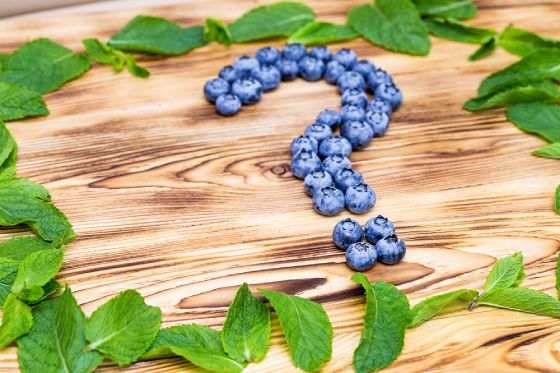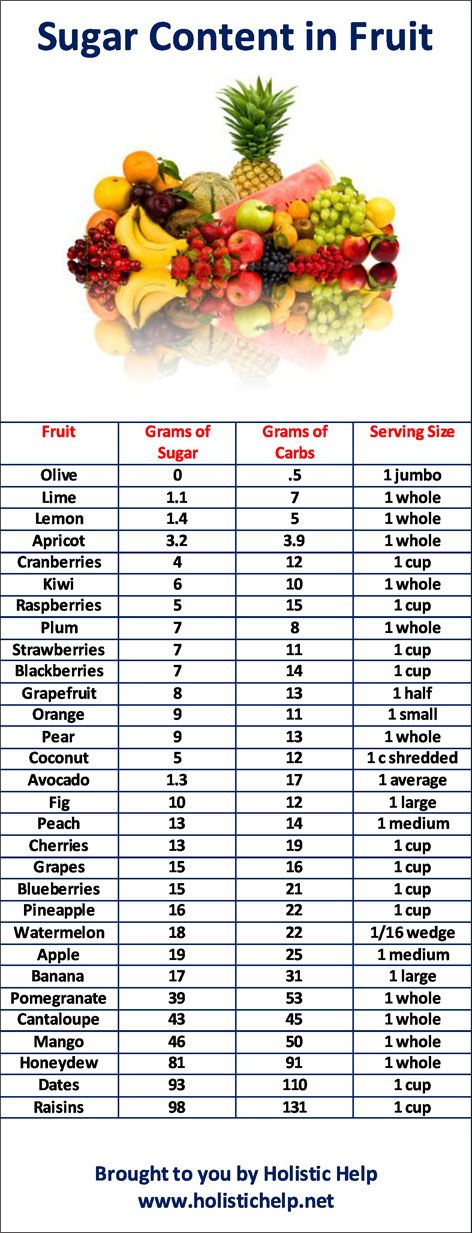Regardless of which health condition you are dealing with, or if you are just taking preventative measures, limiting your sugar intake (even the natural form) is an absolute necessity. Although fruit in limited amounts can provide us with a variety of benefits like antioxidants, fiber, vitamins, and minerals, if too much is eaten, it can be just about as bad as a candy bar and result in degradation of health.
In excess, the sugar content of fruit can disrupt the endocrine system, brain chemistry, the autonomic nervous system, metabolism, gut flora, and the immune system, which can contribute to a very long list of symptoms and conditions like addiction, alcoholism, compulsive overeating, adrenal fatigue, fibromyalgia, neurotransmitter depletion, leptin and insulin resistance, type 2 diabetes, high cholesterol and triglycerides, obesity, insomnia, candida overgrowth, heart disease, anxiety disorders, depression, high blood pressure, hyperactivity, weakened immunity, autism, cancer and much more.
Although fruit is one of the components of the Paleo diet that I promote heavily, there is a big difference between the fruit that our ancestors ate and the fruit that we eat today. Due to cultivation and hybridization, (both man-implemented and naturally occurring) modern fruit is much bigger and higher in sugar content than what grew in the wild. Fiber and nutritional content are also lower in our modern day fruit.
Not only that, fruit was only accessible to our ancestors on a seasonal basis, not year round like it is for us, so their consumption of fruit was much less frequent than ours. Since our biochemistry is a product of our ancestors, our bodies are genetically wired to handle the less sweet versions in moderation, thus why we must make good choices in the fruit that we consume.
So, I’ve compiled this chart with the sugar and carb content of some of the most popular fruits to help guide you in your decision-making process. I’ve presented the sugar and carb content because all carbs break down into sugar, so it is really the carb content that you want to count.
Low Sugar Fruit
Fruit – Grams of Sugar – Grams of Carbs – Serving Size
Olives – 0 grams of sugar and .5 grams of carbs (1 jumbo) (yes olive is a fruit)
Lemon – 1.4 grams of sugar and 5 grams of carbs (1 average)
Lime – 1.1 g and 7 g of carbs (1 whole)
Apricots – 3.2 g and carb 3.9 g (1 whole)
Cranberries – 4 g and carb 12 (1 cup)
Kiwi – 6 g and 10 g of carbs (1 whole)
Raspberries – 5 g and carb 15 g (1 cup)
Plum – 7 g and carb 8 g (1 plum)
Strawberries – 7 g and carb 11 g (1 cup)
Blackberries – 7 g and carb 14 g (1 cup)
Grapefruit – 8 g and carb 13 g (1 half)
Orange – 9 g and carb 11 g(1 small)
Pear – 9 g and carb 13 g (1 whole)
Coconut – 5 g and carb 12 g(1 cup shredded)
Avocado – 1.3 g of sugar and 17 g of carb (1 average) (yes avocado is a fruit)
Figs – 10 g and 12 carbs (1 large)
Medium Sugar Fruit
Peach – 13 grams of sugar and 14 grams of carbs (1 medium)
Cherries – 13 grams of sugar and 19 grams of carb (1 cup)
Grapes – 15 g and carb 16 g (1 cup)
Blueberries – 15 g and carb 21 g (1 cup)
Pineapples – 16 g and carb 22 g (1 cup)
Watermelon – 18 g and carb 22 g wedge (1/6th of melon)
Apple – 19 g carb 25 g (1 medium)
Banana – 17 g and carb 31 g (1 large) However, the riper the banana, the more sugar it contains.
High Sugar Fruit
Pomegranate – 39 grams of sugar and 53 grams of carbs (1 whole pom)
Cantaloupe – 43 grams of sugar and 45 grams of carb (1 melon)
Mangos – 46 g and carb 50 g (1 mango)
Honeydew melon – 81 g and carb 91 g(1 melon)
Dates – 93 g and carbs 110 g(1 cup)
Raisins – 98 grams of sugar and 131 grams of carb (1 cup)
**All dried fruit is exceptionally high in sugar.
So how much fruit should you eat? Well, that depends on your level of health and what you are trying to accomplish. Someone who is weight proportional and in good health may enjoy a serving of fruit with each meal and not have any consequences. If you’re trying to lose weight, you may need to be a little more restricted, which may vary from person to person. However, someone who is trying to overcome insulin resistance, sugar or carb addiction, compulsive overeating, candida overgrowth or fatigued adrenals would do better with no more than 50 grams of carbs per day.
Additionally, other factors may come into play as well. For example, a young woman may be able to eat fruit more freely than a woman who is post-menopausal, as management of insulin appears to be affected by changes in estrogen levels. On the other hand, an athlete may eat more fruit than the average folk, because they are burning off the excess sugar more quickly. Citrus fruits and melons can be problematic for people with candida, more so than other folks.
However, regardless of any of those factors, the best fruit to eat for all of us is the fruit that is lowest in sugar. We want to stick with low sugar fruit the majority of the time, the medium sugar fruit more moderately, and the high sugar fruit should be reserved for special occasions and occasional treats. However, it’s also important to choose fruits that provide you with the richest nutritional value. For example, all berries provide exceptional antioxidant levels. Cherries, prunes, apples, plums, peaches, pears, figs and dates are also good sources of antioxidants. So you want to take into account both the sugar/carb content and the level of nutrients it provides.
So, for example, you might eat strawberries, raspberries, blueberries, cherries, peaches, pears, and avocados on a regular basis; apples and plums occasionally; dates, figs, pineapple, raisins, and banana on special occasions.
And, of course, make sure your fruit is organic. Besides the fact that pesticides, fertilizers and other additives disrupt brain chemistry and the endocrine system, organic fruit is also higher in nutrient content like antioxidants, than its counterpart. When left to fend for itself, fruits and vegetables generate substances called phenolics to protect themselves from pests which prompts an increase in antioxidants. This process is impeded in the presence of pesticides and herbicides.
Fruit is best served with protein and fat, and thus why they go so well with nuts and seeds. When combined with fat and protein, it lowers their glycemic index and thus will minimize the impact of the sugar content on blood sugar, insulin, and neurotransmitters in the brain. For those of you with Candida, it dilutes the accessibility of sugar for the yeast to feed upon. It is also best consumed after a full course meal of animal protein and low-starch vegetables for the same reasons.
Last, but not least, be sure to eat your fruit as a whole food, not a juice. Juices are way too concentrated, high in sugar, and they are missing the pulp that will slow down the absorption of the sugar.
You can print out this handy little guide, if you like, to refer back to in the future. Just right click on the image below and choose “save as” to save to your computer and then print it out.
References
On the Problems of Cultivated Fruit
https://www.marksdailyapple.com/on-the-problems-of-cultivated-fruit/
Hybrid Fruit and Vegetables
https://www.marksdailyapple.com/hybrid-fruits-vegetables/
Google (USDA)





Hi Cynthia–
I am confused by the many differing opinions I read on candida overgrowth, which relates to the fruit and sugar consumption of this post. You recommend the Paleo diet and alternately I have just read an article by a Robert Young, PhD that has a completely different take, mainly to eliminate all meats from the diet based on the fungi they contain and their acidic nature and to include legumes.
Again, I am not sure which diet is most appropriate but tend to eat conservatively, not from any particular “plan” or “diet”.
I eat well with a minimum of grains (brown rice occasionally), no legumes, organic and/or grass fed and finished beef, organic chicken, and wild seafood. I eat organic greens daily and other organic raw and sauteed vegetables. I regularly consume an organic apple daily and a tablespoon of almond butter. I do not tend toward other fruits very frequently. I almost never indulge in any refined sugar or carbs, and never have caffeine, or alcohol. I distill my water and re-mineralize it to a basic constituency. I am not sure what more I can do in terms of diet. I also exercise 5 days per week 1-1 1/2 hours, with a combination of stretching, weight training/isometric, and aerobic. My only indulgence is that this time of year (fall), when in season, I often eat 1 pomegranate daily (I know they are loaded with sugar). I am not allergic or even mildly sensitive to any foods, based on the blood work food allergy testing conducted by my naturopath.
In the last two years I have struggled with allergic asthma which is inhalant caused. My naturopath feels this could be related to yeast overgrowth.
So can you please help me it terms of knowing which diet path is most realistic, either the Paleo or the non-acidic (as described in the attached link’s webpage). I am a blood type O and according to the “Blood Type Diet” regiment the Paleo is recommended. However, it becomes very confusing when everywhere you turn you find differing opinions and informed recommendations.
I am aware, for starters, the pomegranates have to go (which will take care of itself when they go out of season). Any additional insights would be most welcome.
S. Star
Hi Star,
Yes, it is true that meat is acidic. However, low-starch vegetables are alkaline, and when they are eaten with your meat as one does on the Paleo diet, then the vegetables neutralize the acidity and promote a healthy pH.
Someone telling you to eliminate meat is the worse advice one can provide. It’s nonsense.
Legumes contain many anti-nutrients that destroy the gut lining and cause leaky gut, cause nutritional deficiencies and lead to autoimmune disorders. Plus they are high in carbs which means they feed Candida and prompt an insulin response. They should be avoided. The same is true for grains.
Yes, pomegranates are pretty high in sugar, so they should not be eaten frequently.
The science is very clear, the diet that human beings evolved on is the Paleo diet. It is the diet that we are supposed to eat. The Paleo diet provides the body with everything it needs and eliminates everything it doesn’t need. Take a look at the following page on the Eat Right For Your Type
https://www.holistichelp.net/blog/should-you-eat-right-for-your-type/
I would suggest that you read the following pages and take a look at The Primal Blueprint and The Paleo Diet to educate yourself more on the truth.
https://www.holistichelp.net/blog/paleolithic-diet/
https://www.holistichelp.net/blog/being-vegetarian-is-not-healthy/
https://www.holistichelp.net/blog/who-should-eat-meat/
https://www.holistichelp.net/blog/does-eating-red-meat-really-cause-cardiovascular-disease-cancer-and-premature-death/
https://www.holistichelp.net/blog/it%E2%80%99s-excess-carbohydrates-that-will-kill-you-not-red-meat-and-fat/
If you are exercising for an hour or an hour and a half at a time, that is entirely too much exercise in one sitting. That causes great stress on the body. Please read the following page on exercise and take a look at the Primal Blueprint for guidance on exercise as well.
https://www.holistichelp.net/blog/are-you-getting-too-much-exercise/
Best
Cynthia